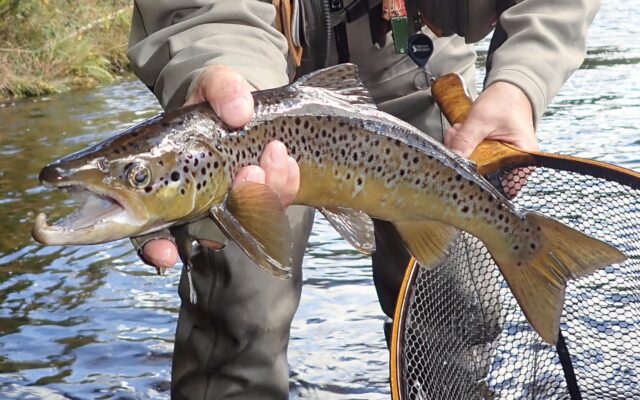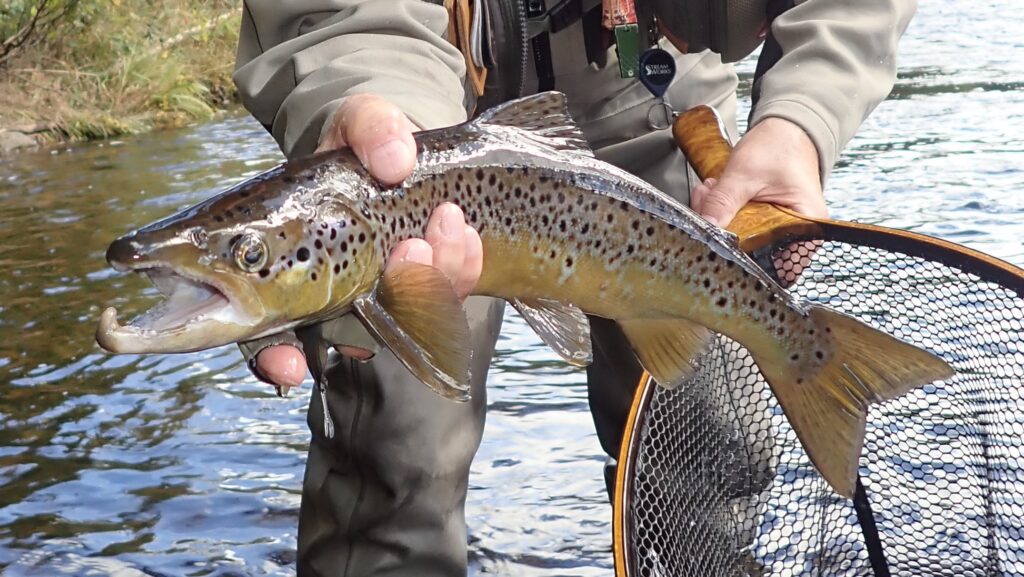
Removing native lake trout is the wrong way to help smelts in Moosehead
By Bob Mallard
I recently read a blog post announcing a fishing derby on Moosehead Lake. The intention was to remove lake trout to reduce pressure on the forage base: smelts. A lack of food can result in “size quality” issues in gamefish such as lake trout and landlocked salmon.
Moosehead Lake is a native brook trout and lake trout water. It was also home to native cusk and lake whitefish, the latter of which served as the primary forage for lake trout. Over the years, Moosehead has suffered a number of nonnative fish introductions, including highly invasive smallmouth bass and white and yellow perch.

LANDLOCKED SALMON — A lean stocked Moosehead Lake landlocked salmon caught in the Roach River near Moosehead Lake.
Moosehead is actively stocked with nonnative landlocked salmon by the Maine Department of Inland Fisheries and Wildlife, and has been since at least 1937. Nonnative smelt were introduced sometime prior to 1944, likely to provide forage for salmon.
According to DIF&W data, lake whitefish have been extirpated — likely due to the introduction of smelt — eliminating an important food source for lake trout.

The Moosehead Lake Togue Derby is a multi-day annual event sponsored by the Natural Resource Education Center at Moosehead, a nonprofit based in Greenville. The person who oversees the derby for the group is a DIF&W fisheries biologist.
The Moosehead derby looks to remove wild native lake trout from the lake to help reduce pressure on smelt. The primary concern is growth rates associated with both lake trout and stocked nonnative landlocked salmon.
A note on the Natural Resource Education Center’s Moosehead Lake Togue Derby Facebook page states the following:
“We need to harvest around 3,000 lake trout under 18 inches to keep that population in check and to maintain our forage base (smelt). … We are encouraging anglers to harvest their limit of smaller lake trout for the remainder of the winter.”
According to the center, the three “winning” lake trout harvested as part of the derby measured from 36 to 40 inches and weighed 10.71 to 11.71 pounds. Its post said, “The big fish were long and lean this year,” showing that there is a forage issue on Moosehead Lake.
When your stated mission is to create larger gamefish, it seems as though you would want to discourage the harvest of large fish and focus your attention solely on smaller fish to reduce the overall numbers.
As a native fish advocate, I struggle with the idea of removing wild native lake trout while we are stocking a nonnative fish. I also struggle with the idea that smelt, a nonnative and highly invasive baitfish, should be protected.
We are trying to get too much out of Moosehead Lake, especially when you consider what we are up against in the proliferation of nonnative bass. While we hold a tournament to remove 3,000 wild native lake trout from Moosehead each winter, we stock 5,000 nonnative landlocked salmon a few months later each spring.
Rather than working hard to remove 3,000 wild lake trout a year via a tournament, why don’t we consider suspending the stocking of 5,000 landlocked salmon a year, which would result in 2,000 fewer mouths to feed? This would also save money, and allow us to use our limited hatchery resources where they are most needed.
We should also consider focusing our efforts on removing nonnative smallmouth bass to reduce predation and competition for food and space with brook trout, a self-sustaining native species that is seeing a bit of a resurgence in Moosehead lately. What would 3,000 or so fewer bass do for the wild native brook trout population?
Moosehead Lake is the largest wild native brook trout water located wholly in the United States. It is a resource that can produce brook trout that would be considered trophies anywhere in the nation, and even Canada. This is where our focus should be, not stocked nonnative landlocked salmon and faltering nonnative smelt.
After 14 years of lake trout culling tournaments on Moosehead Lake, we still have a size-quality problem with both lake trout and landlocked salmon. The same thing can be said about nonnative smelt that have been imported from other waters and stocked as juveniles with limited success.
A water can only support so many pounds of fish, especially oligotrophic lakes such as Moosehead. We are contributing to our own problems at Moosehead by trying to be everything to everyone. At a time when resources are lean and costs are going up, our focus should be on wild native fish wherever possible. Could we try to let Moosehead be what it once was — a wild native brook trout and lake trout fishery of note? Could we focus on removing, and not adding, nonnative fish rather than native fish?